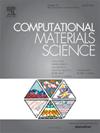Formation of three-dimensional dislocation networks in α-iron twist grain boundaries: Insights from first-principles neural network interatomic potentials
IF 3.1
3区 材料科学
Q2 MATERIALS SCIENCE, MULTIDISCIPLINARY
引用次数: 0
Abstract
We conducted a systematic analysis of the atomic structure and energy of (001), (110), and (111) twist grain boundaries (TWGBs) in -iron using a recently developed neural network interatomic potential (NNIP). This study showcases typical dislocation networks within TWGBs that exhibit small twist angles. Notably, we observed a three-dimensional (3D) dislocation network in (111) twist grain boundaries, primarily composed of dislocations—structures unattainable using previously proposed empirical potentials, hence unreported in earlier studies. The novel 3D dislocation network was further validated through several approaches, including principal component analysis (PCA), an NNIP ensemble model, and cross-validation with other machine learning interatomic potentials designed for -iron. This breakthrough offers a new perspective on the properties of twist grain boundaries, potentially impacting our understanding of their strength, toughness, and mobility.

我们利用最近开发的神经网络原子间势(NNIP)对α-铁中(001)、(110)和(111)扭曲晶界(TWGB)的原子结构和能量进行了系统分析。这项研究展示了表现出小扭转角的 TWGB 内的典型位错网络。值得注意的是,我们在(111)扭转晶界中观察到了三维(3D)位错网络,主要由 12〈111〉位错组成--这种结构是以前提出的经验位势无法实现的,因此在以前的研究中没有报道过。新颖的三维位错网络通过几种方法得到了进一步验证,包括主成分分析(PCA)、NNIP集合模型以及与其他为α-铁设计的机器学习原子间位势的交叉验证。这一突破为研究扭曲晶界的特性提供了新的视角,可能会影响我们对其强度、韧性和流动性的理解。
本文章由计算机程序翻译,如有差异,请以英文原文为准。
求助全文
约1分钟内获得全文
求助全文
来源期刊

Computational Materials Science
工程技术-材料科学:综合
CiteScore
6.50
自引率
6.10%
发文量
665
审稿时长
26 days
期刊介绍:
The goal of Computational Materials Science is to report on results that provide new or unique insights into, or significantly expand our understanding of, the properties of materials or phenomena associated with their design, synthesis, processing, characterization, and utilization. To be relevant to the journal, the results should be applied or applicable to specific material systems that are discussed within the submission.
 求助内容:
求助内容: 应助结果提醒方式:
应助结果提醒方式:


